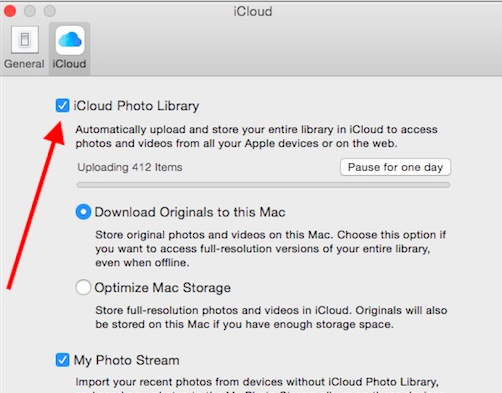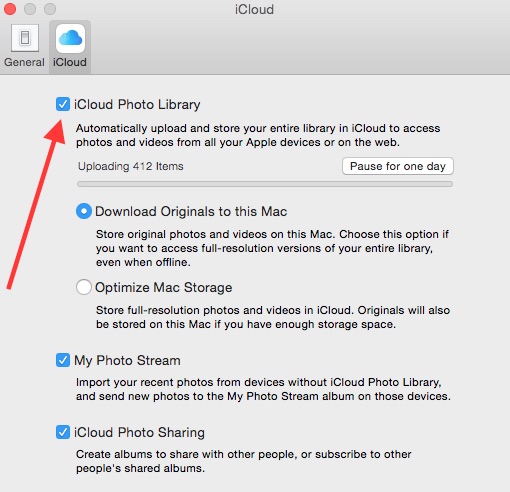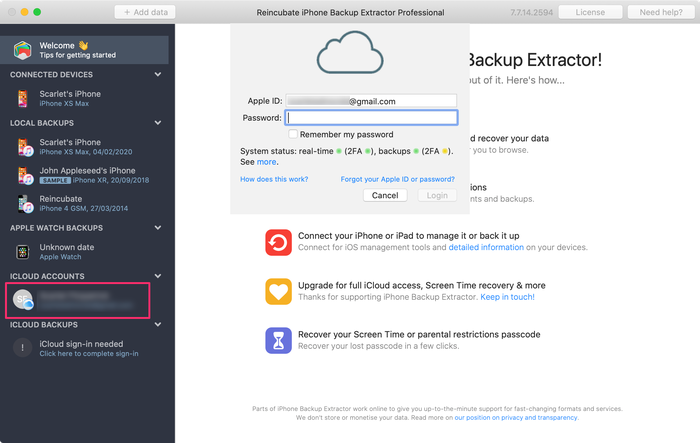Nov 23, 2018 Another way to move photos from an iPhone to a Mac is with iCloud. ICloud Photo Library, a.k.a. ICloud Photos, can do all the heavy lifting. However, if you’ve got over 5GB of photos and videos, you’ll need to upgrade your storage plan, paying anything from $0.99 per month for 50GB to $9.99 for 2TB of cloud storage. In the iCloud tab, make sure iCloud Photo Library is enabled. It may not be, because you switched libraries. It may not be, because you switched libraries. Then choose Download Originals to This Mac.
iCloud is one of the best cloud services offered by Apple. This service will allow you to backup all your iOS data. Coming to your photos, iCloud will allow you to view them from anywhere and from any device. All you need is your Apple ID and a stable internet connection. Maybe you don’t know how to access iCloud photos on iPhone, Mac, or Windows PC. You shouldn’t worry though. This article will change that.
- 1: How to Access iCloud Photos on iPhone?
- 2: How to Access iCloud Photos on Mac?
- 3: How to Access iCloud Photos on Windows PC?
- Bonus: Best Tool to Manage Photos: Back Up/Compress/Permanently Delete
How to Access iCloud Photos on iPhone?

To view your iCloud photos on your iPhone, all you need to do is turn on the iCloud Photo Library. If you have access to an internet connection, your iCloud photos should sync to your iPhone. Follow the steps below to access the iCloud photos on your iPhone:
Steps to Access iCloud Photos on iPhone
Step 1: Launch Settings and tap iCloud.
Step 2: Use your Apple ID and Password to log in if you are not already logged in.
Step 3: Click Photos, tap the iCloud Photo Library switch to toggle it on.
Step 4: Go back to the home screen and click Photos app to launch it. Tap Albums. If Wi-Fi is on, your iCloud Photos should be available in your albums.
How to Access iCloud Photos on Mac?
For you to be able to view your iCloud photos on your Mac computer, you will need to turn on your iCloud Photo library. This is not complicated to do. The following steps should help you activate iCloud Photo Library on your Mac:
Step 1: Open the Apple Menu and then select the System Preferences. Under the System Preferences, select iCloud.
Step 2: Use your Apple ID and Password to sign in. Activate the Photos option under iCloud by ticking the checkbox next to it.
Step 3: Click the Options button next to Photos. Activate both the iCloud Photo Library and My Photo Stream. Click Done. As long as the computer is connected to the internet and it has enough space, your iCloud photos should be downloaded to the computer where you can access them easily.
How to Access iCloud Photos on Windows PC?
If you are on Windows PC and need to view your iCloud photos, you will need to download iCloud for Windows first. After downloading this free Apple tool, follow the steps below to access your iCloud photos on Windows PC:
Step 1: Install iCloud for Windows on your PC. Launch the tool and use your Apple ID and password to sign in.
Step 2: Next to Photos, tap Options. In the window that opens, select iCloud Photo Library and My Photo Stream. Click Done. As long as you are already connected to the internet and the Windows PC does have enough storage space, your iCloud Photos should sync to your computer where you can check them out.
Bonus: Best Tool to Manage Photos - Back Up/Compress/Permanently Delete

Managing photos is not an easy task on iOS devices. However, it can be made much easier when you have a professional tool designed to help in the management of the photos. Such a tool is available and it is known as the iMyFone Umate Pro. This tool will help you manage your photos on all your iOS devices. That is, you can use it with an iPhone, iPad, or even an iPod Touch. It will work with devices running the latest iOS versions. The features present in iMyFone Umate Pro include:
Options for Photos
- Save Space: back up the photos to your computer or compress them to save space.
- Safeguard Privacy: erase your private photos from your iPhone with a 0% chance of their recovery.
- Erase Deleted Photos: locate and erase the photos deleted by conventional method.
iMyFone Umate Pro is capable of erasing more than just your Photos. It can erase other data such as videos, messages, contacts, call history, browsing history, and data generated by third-party applications such as WhatsApp, Kik, Line, and Viber. Before erasing your data, you get to preview it so that you can erase it selectively.
It's recommended by lots of noted media arround the world: MacWorld, iPhoneinCanada, APPKED, etc.
Steps to Manage Photos for iPhone
Step 1. Download, install and open iMyFone Umate Pro on your computer.

Step 2. Connect your iPhone to computer and Select Photos tab under the 1-Click Free Up Space function. It will show you how much space you can save for your iPhone by compressing/backing up/deleting photos.
Function 1: Compress photos losslessly
The Backup & Compress option can save you up to 75% of your camera space. After selecting this option, all your photos will be backed up to your computer.
Then it will compress the photos, this process can free up to 75% of your iOS storage space.
Function 2: Export and Delete Photos
This option will export your photos to PC and delete them from your iOS device. First, you need to select the unwanted photos, then click on Export & Delete, if you only want to backup your photos, you can click 'Export Only'.
After the process finished, you will see how much storage has been saved.
Function 3: Permanently Erase iPhone Photos
Do you worry that your private photos or other personal information on your mobile devices may be revealed to others? iMyFone Umate Pro will delete all of this residual information completely and permanently. It can make sure the private photos will be rendered unrecoverable.
You may also like:
Want to easily back up your iPhone's photos and video, sync them with your other devices, and share them with friends? Apple's iCloud Photo Library service lets you do all that while keeping your storage space free to take even more beautiful 4K video and HDR photographs.
When enabled, the service backs up every photo and video you've snapped or saved to iCloud (assuming you've paid for enough iCloud storage space). Also, it syncs those files across all other iPhone, iPad, Mac, Apple TV, and Apple Watch devices you own and have logged in to that same iCloud account.
iCloud Photo Library will save photos, videos, GIFs, screenshots, and more — and even better, when you enable it, you can use Optimize Storage to send your files immediately to iCloud and keep them from cluttering up your iPhone's local storage space.
Here's how to set up iCloud Photo Library on your iPhone or iPad to back up your photos and video, optimize storage on your devices, and share images with your friends and family.
How to set up iCloud Photo Library on your iPhone or iPad
Note: To set up iCloud Photo Library, you must first have an iCloud account.
- Launch the Settings app on your iPhone or iPad.
- Tap the Apple ID banner at the top of the screen.
Select the iCloud option.
Source: iMore
- Tap Photos.
Tap the iCloud Photo Library toggle at the top of the screen to turn the service on or off.
Source: iMore
How to quickly sync images with your other devices
When you enable iCloud Photo Library, your photos and video will by default automatically upload to iCloud, and eventually sync with your other iOS devices and Macs. If you'd like to expedite this process, however, you can enable My Photo Stream: This will automatically sync any images you take to your other devices when you (and they) are connected to a Wi-Fi network.
It is worth noting that this only works with images: Apple doesn't currently support quick syncing with video files just yet.
Tip: If you frequently swap between your iPhone and iPad and want to use screenshots or photos you've recently taken on either, this is worth enabling.
- Launch the Settings app on your iPhone or iPad.
- Tap the Apple ID banner at the top of the screen.
Select the iCloud option.
Source: iMore
- Tap Photos.
Tap the Upload to My Photo Stream toggle to enable instant photo and video sync over Wi-Fi.
Source: iMore
If you choose to enable quick sync between your devices in the form of My Photo Stream, you can additionally enable the Upload Burst Photos option to sync every image in a Burst collection; otherwise, iCloud will only sync the Favorite photo from a Burst collection to save space.
How to optimize your photo and video storage
If you routinely shoot lots of 4K video or high-quality images on your iPhone or iPad, you may run out of storage space on your device. (I have a 256GB iPhone, but almost a terabyte of 4K video stored in iCloud — it gets unwieldy, fast!)
Thankfully, Apple offers an Optimize Storage option, which lets you store full-resolution photos and videos of only your most recently shot and accessed imagery; all older photos and videos are available to download via iCloud and are stored as low-resolution previews on your iPhone to save space.
You can switch between optimizing your iPhone's storage or storing your full library locally: Here's how!
Note: If you plan on using Optimize Storage, we suggest having at least one device that stores your entire library locally (usually a Mac with a large local or external hard drive), so you have multiple backups of your photographs and video.
- Launch the Settings app on your iPhone or iPad.
- Tap the Apple ID banner at the top of the screen.
Select the iCloud option.
Source: iMore
- Tap Photos.
Choose either the Optimize iPhone Storage option or the Download and Keep Originals option.
Source: iMore
How to share photos with iCloud Photo Library
Apple's photo service doesn't just provide online backups and sync for your images and video: The company also offers a free sharing service that allows you to send shared albums to friends and family (or create a publicly-shared website). Here's how to turn it on.
Any other questions?
Have a question or comment about getting started with the iCloud Photo Library? Let us know in the comments.
Updated January 2020: Updated with more information about iCloud Photo Library, My Photo Stream, and optimizing your storage. Serenity Caldwell worked on a previous version of this post.
More Apple TV+ contentIcloud Photo Library Iphone To Mac Free
Martin Scorsese's next movie might come to Apple TV+ after Paramount walked
Icloud Photo Library Iphone To Mac Pro
Spiraling costs have put Paramount off Scorcese's next gig and Apple TV+ is one potential suitor. Netflix is said to be another potential avenue.